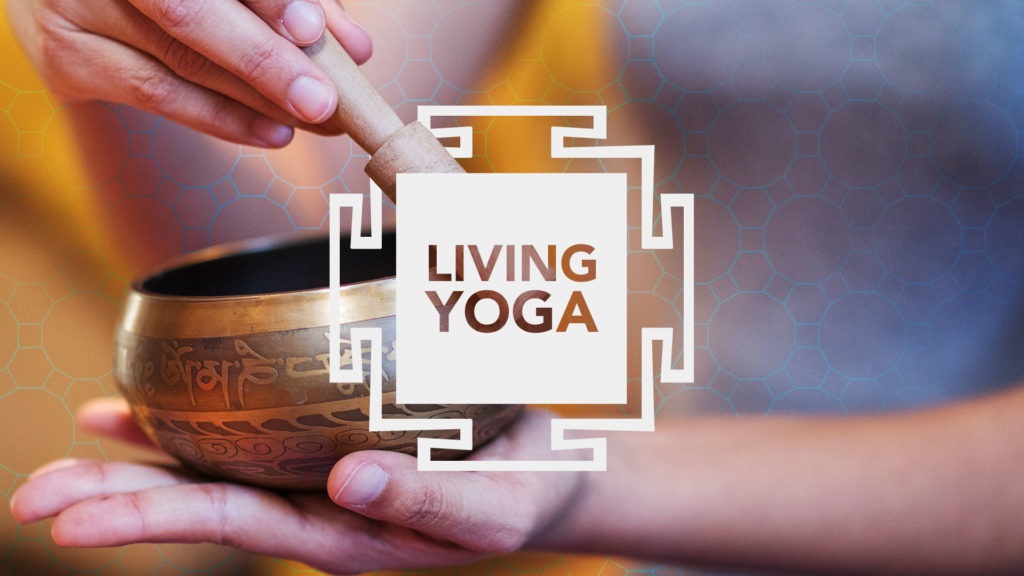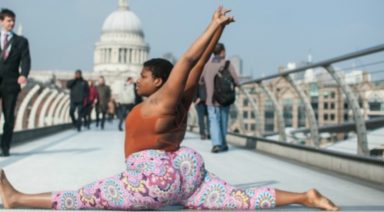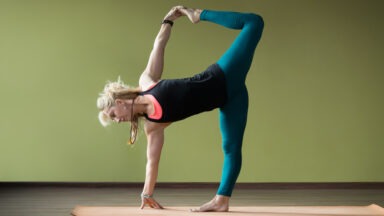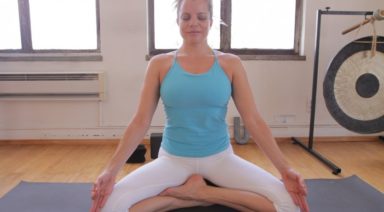Living Yoga | Members Only

Living Yoga: Make Yoga Your Lifestyle
Yoga is more than the practice of asana, or physical postures. Living yoga means integrating the principles of yoga into your thoughts, words and actions; it means taking yoga beyond your mat. Learn more about living yoga and explore a variety of class option such as Tantrik Meditations, Yogic Paths and Injury, Inquiry and Insight to expand your practice.
The Eight Limbs of Yoga
The Eight Limbs of Yoga are core principles that serve as a compass for living a meaningful and purposeful life.
1. Yamas
Yamas are ethical considerations to help guide interactions with others. There are five yamas:
- Nonviolence (Ahimsa)
- Truthfulness (Satya)
- Non-stealing (Asteya)
- Chastity and fidelity (Brahmacharya)
- Non-coveting (Aparigraha)
At first glance, these considerations mirror the basic morals taught in kindergarten, but have depth in their continued practice. Here are a few alternative versions to consider:
- Ahimsa: practice nonviolence in thought, word and deed; practice self-love
- Satya: tell the truth; opt for silence if your words may harm others
- Asteya: do not steal, even in non-material ways, such as withholding information or time
- Brahmacharya: use your energy wisely and with intention; avoid excess or overindulgence
- Aparigraha: you are enough and you have everything you need already
Please keep in mind that there are many interpretations of the Yamas and Niyamas; find the definitions best suited to your personal practice.
2. Niyamas
The Niyamas are practices that inform self-discipline and worldview. The maxims below generally reflect the essence of each Niyama:
- Saucha: “Leave a place cleaner than you found it” (cleanliness)
- Santosha: “Don’t worry, be happy” (contentment)
- Tapas: “When the going gets tough, the tough gets going” (willpower and self-discipline)
- Svadhyaya: “Learn from your mistakes” (study of self and sacred scriptures)
- Ishvara Pranidhana: “Have faith” (surrender to the divine)
3. Asana
Asana refers to the physical postures practiced in yoga. Derived from the root word as in Sanskrit, which means seat, asana is designed to prepare the body and mind for seated meditation. The term asana refers to the ancient yogic tradition of taking a seat close to your teacher. Beyond the physical, asana refers to an outlook that life is full of opportunities to learn, even through obstacles: find the teacher in all things.
Introduction to Tantrik Yoga
Learn the basics of Tantrik Yoga, such as how to use breath, mantra, mudra and awareness to unlock and unfold the hidden potentials that lie within every human being.
4. Pranayama
Breathing is the only bodily function that you perform consciously and unconsciously; it can be voluntary or involuntary. However, breathing patterns, such as a tendency to hold your breath, are indicators of mind and body health. Pranayama is the practice of consciously controlling the breath, of taking your breath back into your own lungs. In Sanskrit, prana is our vital life force, so pranayama is the cultivation and mindful use of life force. Pranayama leads to improved concentration, health, focus, clarity, creativity, purpose and compassion.
5. Pratyahara
Pratyahara is the practice of withdrawing from external stimuli to enhance internal awareness. Mindfully return to quiet through meditation and removal of distractions. Set aside 5-10 minutes each day to sit or lay quietly with your eyes closed. As your practice grows, your heightened sense of awareness leads to an ability to see things are they are, not as you are. Draw inward, not to silence your senses, but to quiet them enough to see beyond yourself.
6. Dharana
Dharana is the practice of intense concentration, usually focusing on one object, such as the flame of a candle or a picture of a deity. This practice trains the mind in stillness and focus. Start with just a few minutes each day and expand your practice as it serves you. If other thoughts or distractions flicker through your experience, recognize them then let them go.
7. Dhyana
Dhyana is the state of being keenly aware, yet without focus. It is awareness without judgment or attachment; it is peaceful, meditative and precedes complete bliss. It is otherwise known to artists and athletes as the flow state. Consider moments in your life where you were so engrossed in the present that you lost track of time or desire (even for food). The practice of yoga offers a return to this state.
8. Samadhi
Samadhi is a state of ecstasy. It is transcendence, connectivity with the divine, a coupling with the universe, and a mind-body integration of the concept that “all things are one.”
Who is Patanjali?
Patanjali, a revered scholar in the yogic tradition, is credited with authoring the Yoga Sutras, a foundational text for classical yoga. In the Yoga Sutras, the eight limbs are referred to as ashtanga, ashta meaning eight and anga meaning limb in Sanskrit. Patanjali is estimated to have lived in India sometime between the 5th century BCE to 4th century CE.
Get your guide to living yoga featuring Patanjali’s Eight Limbs of Yoga.
The Glass Ceiling of Yoga: Body Positivity

The picture of a serene and beautiful yoga community that is celebrated by the media actually disguises a disturbing layer of normalized and ubiquitous body type discrimination. However, by unveiling a previously “invisible” glass ceiling over the Western yoga community, students, teachers, and administrators can find ways to effortlessly mold body-positive practice spaces for current, new, and future yoga practitioners.
Gender vs Body Type
I’ve encountered a lot of glass ceilings in my life. Honestly, when you’re black, queer, and born with female genitalia, you encounter them constantly and I’ve grown to expect situations wherein boundaries and limitations are the norm. However, there’s a glass ceiling that limits our Western yoga community to a troubling degree and it’s something I never expected to encounter. I mean, when “glass ceilings” are typically identified in Western society, they are almost invariably related to gender.
Ironically, the yoga community doesn’t really suffer from a gender glass ceiling, at least not one that negatively effects women.
Even though women weren’t taught asana until the 20th century, the vast majority of Western yoga teachers and students are female. And while discrimination against male yoga students and teachers is probably more common than any of us could imagine, it’s still not the most expansive and divisive glass ceiling in the yoga community.
No, the real ceiling within our community is based entirely upon physical presentation and, specifically, body type.
This ceiling is clear as day to those of us who have atypical yoga practitioner bodies. Instead of being slender, white and heaped with physical ability, there’s a growing wave of yoga teachers and students who are plump, multiethnic and powering through life with a wide range of disabilities. However, those of us who challenge the white washed yoga teacher stereotype face a very different practice landscape than our colleagues. For example, it’s inappropriately common to hear a story about a yoga student being shamed out of a yoga studio, based upon comments made by discriminatory yoga teachers and students.
In some communities, it’s nearly impossible for atypical yoga teachers to find teaching opportunities. And even when teaching opportunities are available, they are not on par with options for more traditionally bodied teachers. This problem is well documented within small communities of “different” yoga teachers, but it’s essentially invisible to those who don’t see themselves as “different”. And, what’s worse, there are way too many practitioners and teachers who don’t see this kind of discrimination as a problem. Thus, an “invisible” glass ceiling has domed over our community, and only those who have been discriminated and oppressed are fully aware of its existence.
What Does This “Glass Ceiling” Actually Look Like?
Here’s the thing, no one in the yoga community is ever going to openly bad mouth someone who looks different from the traditional idea of a practitioner. Ok, let me back up. I’m sure it happens. But being openly mean to people is not condoned in our yoga community. It’s a pretty big no-no, actually. Therefore, I wouldn’t be surprised if someone reading this article right now is truly shocked by the idea that discrimination exists in a community which oozes the kind of saccharine sweetness that can only be honed by decades of marketing and product advertising. Unfortunately, the prettiest bandages can hide the ugliest wounds.
And beneath the surface of our saccharine sweet, mass media approved industry is a festering wound characterized by offensive language, discriminatory hiring practices and a bunch of other negativity that gets swept under the rug.
Admittedly, it’s not fun to acknowledge discrimination. In most cases, it feels very embarrassing, and many people would prefer to pretend as though they are not part of the problem. But anyone who turns a blind eye to this problem is also a key contributor to its existence. But how does this problem actually manifest and what does it look like? Let me paint a clearer picture for you.
Imagine you’re a curvy person who has finally decided to face your fear of practicing yoga in a group setting. Perhaps you’ve practiced yoga online with free videos, and you’re finally feeling confident enough in your understanding of asana to venture out of your living room and into a communally supportive environment under the watchful gaze of a knowledgeable instructor.
With a yoga mat under your arm and an emotionally swollen heart on your sleeve, you proudly stride into your local yoga studio.
When you approach the reception desk to check-in for class, the teacher (who looks, as expected, like a human Barbie doll) gives you a curt visual once-over. “Is this your first class?” Yoga Teacher Barbie chirps nonchalantly. While your knee jerk reaction may be defensive, you calm yourself down mentally. You remind yourself that she’s not trying to be offensive, and that she’s merely trying to take the proverbial temperature of a student she’s never met before. You smile and shake your head. “Nope, but I’m excited to take your class!” you say. Barbie smirks. “Well, this class is pretty intense,” she says.
You stare at her blankly. You’re wondering why she’s decided to tell you that the class is intense. Is it because she thinks you can’t handle the class? All of a sudden, you’re second guessing yourself and hiding sweaty palms. Why did you think you were strong enough to attend live classes? By the time you’ve rolled out your mat and gotten settled with props, the tissue thin confidence you brought into the studio has been shredded beyond repair by the self-doubt you’d managed to keep at bay prior to arrival.
During the class, you notice for the first time that your expressions of various yoga poses look a little different than other people in the class. Maybe your balance is a little less sharp, or you use props and modifications at times when other students seem to be able to go without. While that acknowledgement makes you a little self-conscious, it pales in comparison to the shame you feel at having your movements constantly corrected by Yoga Teacher Barbie.
Because, yes – Barbie has also noticed that your movements look a little different. And she’s decided to make your differences an opportunity for a teaching exercise by constantly correcting your alignment and offering more physical adjustments than you could have ever wanted. Ultimately, it doesn’t matter if she’s offering more or less advice to anyone else in the room – in fact, it’s entirely possible that she offers this level of adjustment to every student. But your confidence has been shattered.
The emotionally swollen heart you proudly wore on your sleeve is now openly bleeding.
In the best case scenario, you somehow find the strength to believe in yourself again. In the worst case, you vow to never darken the doorstep of another yoga class for fear of ever feeling this way again.
The thing is, if you’re reading this right now, you’ve probably worn the moccasins of either Yoga Teacher Barbie or our Curvy Protagonist. Maybe both. And the weird thing is, I’ve heard this exact same story told by people who are not necessarily “curvy” or “different” in some other way.
In fact, it’s startlingly common for people who look just like Yoga Teacher Barbie to still feel discrimination at the hands of their instructors.
I could be wrong, but I think this is all the result of the fact that we live in a staunchly body negative society.
Body negativity is endorsed by the mass media – let’s face it, that’s how they get us to buy things. We make purchases because we find ourselves wanting or lacking in one way or another. Unfortunately, in addition to the mass media, body negativity has also fully permeated the yoga community. In fact, many teachers believe their discrimination isn’t discrimination at all – they see it as a kind dose of realism to students who don’t meet their personal standards of yoga perfection. Because that’s really all discrimination is – it’s the state of our judgment when we encounter people, places, and things which jibe with our personal definitions of perfection.
It’s sad to see this happen in a community which has the potential to include every single human being on the planet. Frankly, it’s not absurd to imagine a world where everyone practices a style or hybrid blend of yoga. However, that reality will never come to fruition if we don’t resolve the body negativity and discrimination problem. How do we do that? Well, fight fire with fire.
If body negativity is the disease, then body positivity must be the antidote.
The Antidote: Body Positivity
Body positivity is frequently confused concept. It’s pretty confused even within the body positivity community. You could get a different definition depending on the person you ask, the day of the week, etc. Some people think body positivity is solely tied up in body size acceptance, and others might even go so far as to equate it with fat acceptance and fat positivity. While fat positive movements have their rightful place of importance in the evolution of our society, I don’t believe they are synonymous with body positivity. Another popular way of describing body positivity is by equating it with constant self-pep talks. You know, a pattern of methods to remind yourself that “I’m Great! I’m Beautiful! I’m worthy of breathing oxygen in front of other humans without feeling suicidal!” While pep talks are rad and I fully endorse them, I don’t think they speak to the core of body positivity.
You see, body positivity assumes your constant perfection. It assumes that you’re always beautiful. That you’re always worthwhile. That you’re always capable. That you’re always strong.
In a truly body positive world, these statements are not up for debate – instead, they are seen as impenetrable fact. The only perspective up for debate is that of each individual – are you willing to accept your own perfection? Especially when the mass media tells you that those statements are definitely not true. Body positivity is the confidence to accept your constant perfection and beauty, no matter the proverbial weather. And, most importantly, to accept the constant perfection and beauty of those around you, even if they look and act different from yourself.
When we implement body positivity in our yoga studios and spaces, we create environments where students across an infinite spectrum of differences all feel as though they are equal to one another. This type of attitude is absolutely critical in order to see the yoga community grow beyond the one dimensional image offered by the media. Body positivity doesn’t mean teachers aren’t free to offer alignment tips and adjustments to their students without fear of offending someone. But it does mean that every word, every gesture, and every moment is an opportunity to be encouraging. To make someone feel welcome. To actively avoid discouragement.
Eventually, this kind of environment will lead to the end of classes where certain students are viewed as superior to their fellow students. Good riddance, as far as I’m concerned. This is a glass ceiling that desperately needs to be shattered.
We must all take responsibility for the role we play in a yoga culture which is thoroughly embedded in discrimination and negativity.
We need more than a few people who are proud of their bodies. We need a legion of yoga teachers, administrators and advanced practitioners who truly walk the walk of the eight-limbed path, and who will stop at nothing to spread the practice to every soul across the planet.







































